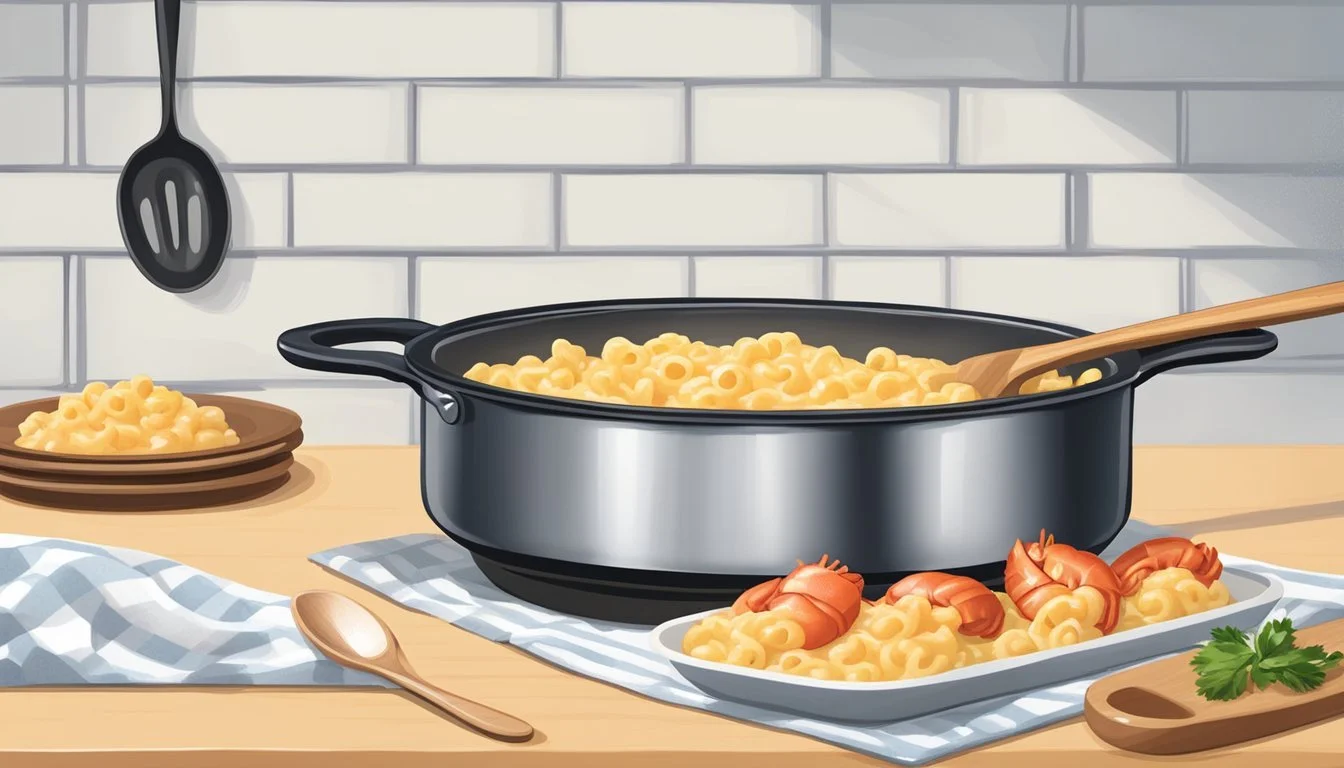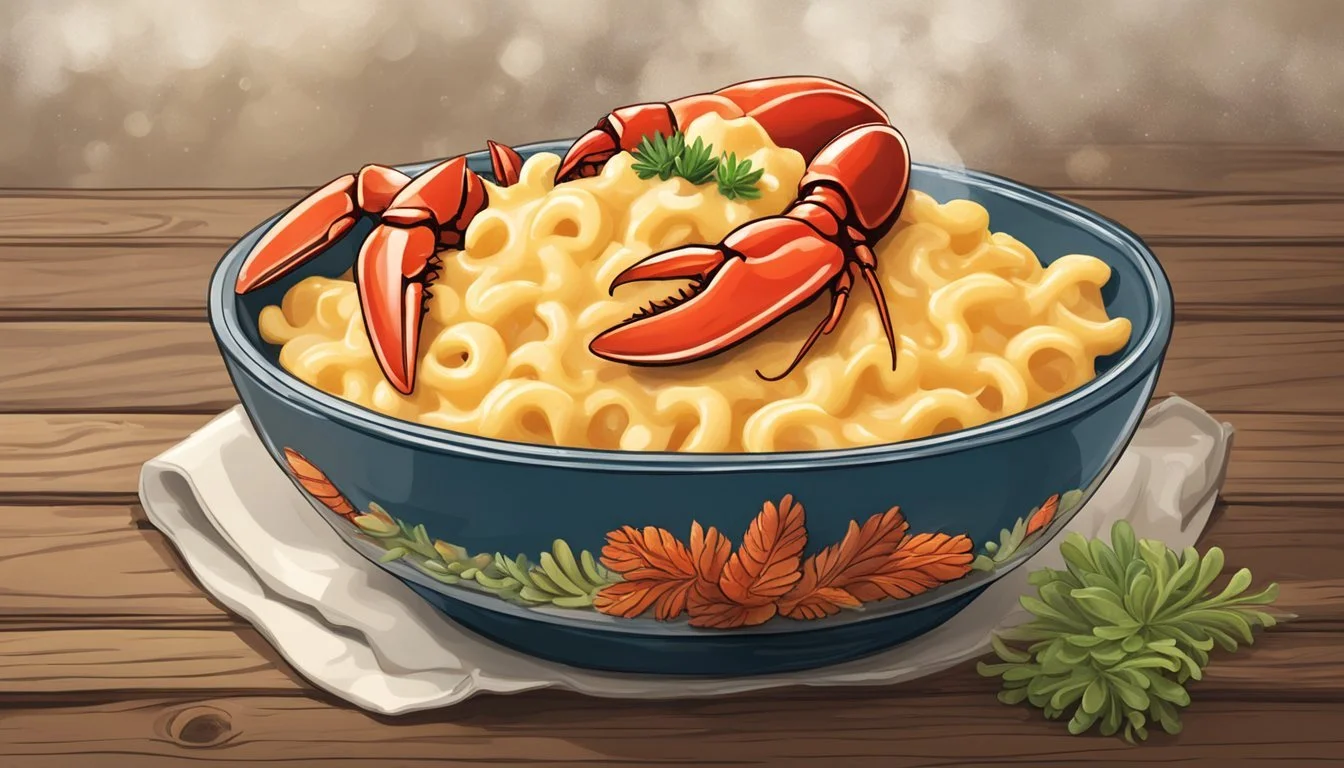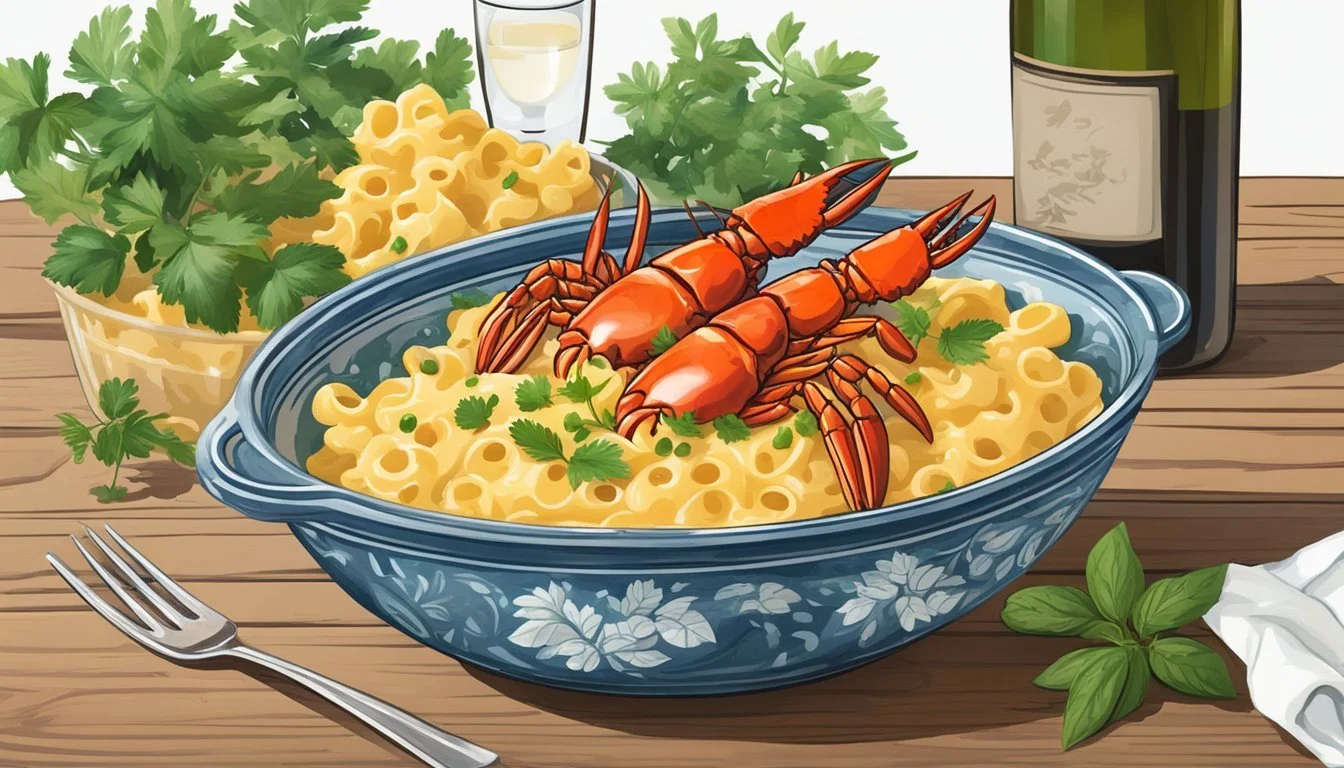Best Way to Reheat Lobster Mac and Cheese
Tips for Creamy Perfection
Reheating lobster mac and cheese requires a delicate balance to maintain its creamy texture and avoid drying it out. Lovers of this sumptuous dish know that it is not just about warming it up; it's about recapturing the fresh-out-of-the-oven quality. Multiple methods exist for reheating, each with their own merits, and some are better suited for preserving that delectable creaminess that is the hallmark of a good lobster (What wine goes well with lobster?) mac and cheese.
The oven method is commonly recommended for its even heating and ability to restore the gentle crispness to the breadcrumb topping often found in this dish. Careful attention is paid to temperature and timing, as well as to covering the dish to retain moisture. Microwaving, while quicker, requires a different approach to avoid a rubbery texture in the lobster or overcooked pasta. By understanding the nuances of these methods, individuals can ensure that the lobster mac and cheese retains its luxurious quality, even after a stint in the refrigerator.
Understanding the Composition of Lobster Mac and Cheese
Lobster mac and cheese is a gourmet twist on the classic comfort dish. Its composition is crucial to maintaining its luxurious texture and rich flavor when reheating.
The pasta typically used is elbow macaroni or shells that hold the cheese sauce well. The choice of pasta is important as it forms the base of the dish, and tends to absorb the sauce.
Cheese forms the creamy backdrop of the dish, with shredded cheese varieties such as cheddar, Gruyère, or fontina often blended to create a multi-dimensional flavor profile. The way these cheeses melt affects the overall creaminess of the dish.
Cream is often included in the cheese sauce to add richness. A roux-based sauce, incorporating a blend of butter, flour, and milk or cream, ensures the cheese sauce has a thick, velvety texture.
Lobster adds the decadent touch. Often cooked and then cut into bite-sized pieces, lobster meat is folded into the mac and cheese before baking, infusing the dish with seafood sweetness.
Finally, breadcrumbs may be sprinkled on top to provide a contrasting crunch. When properly toasted, they add a textural element that complements the smoothness of the mac and cheese.
Key Components Role in Dish Notes Pasta Base Holds sauce, absorbs flavors Shredded Cheese Creaminess Meltability is crucial Cheese Sauce Flavor Typically roux-based with cream Lobster Decadent Touch Cooked, then cut into pieces Breadcrumbs Textural Contrast Optional; adds crunch
This dish's rich complexity requires careful reheating to preserve its intended melding of flavors and textures.
Pre-Reheating Steps for Optimal Flavor
Ensuring that lobster mac and cheese retains its creaminess and rich flavor when reheated involves crucial pre-heating steps. These steps are designed to prevent dryness, enhance flavor, and ensure the dish is safely reheated.
Ensuring Safety and Quality
Before reheating lobster mac and cheese, check that the dish has been stored properly in the refrigerator or freezer to prevent the growth of bacteria. If refrigerated, it should be consumed within three to four days, and if frozen, it should be thawed safely in the refrigerator. An airtight container is ideal for storage to maintain freshness and avoid contamination.
Refrigerator: Consume within 3-4 days
Freezer: Thaw in the refrigerator
Preparing for Reheating
Careful preparation of lobster mac and cheese before reheating can help maintain its quality. For oven reheating, one should preheat their oven to 350°F (175°C), and transfer the leftover mac and cheese into an oven-safe dish. When using a microwave, the leftover should be placed in a microwave-safe dish.
Oven: Preheat to 350°F (175°C) and use an oven-safe dish.
Microwave: Use a microwave-safe dish.
Adding Moisture to Prevent Dryness
Adding moisture is essential to prevent the lobster mac and cheese from becoming dry. Before reheating, one can add a small amount of milk, cream, or a pat of butter to the dish to enhance its creamy texture. Cover the dish with aluminum foil or a lid when using an oven or a microwave-safe lid or plastic wrap when using a microwave to create a moist cooking environment.
Moisture Boost: Add milk, cream, or butter.
Oven: Cover with aluminum foil.
Microwave: Cover with a microwave-safe lid or plastic wrap.
Methods for Reheating Lobster Mac and Cheese
Reheating lobster mac and cheese properly ensures that it stays creamy and delicious. The following are effective techniques to preserve the dish's quality.
Oven Reheating Technique
To reheat lobster mac and cheese in an oven, preheat the oven to 350°F. Place the mac and cheese in an oven-safe dish, cover it with aluminum foil to retain moisture, and bake until the internal temperature reaches 165°F. For a crispy topping, remove the foil in the last few minutes of reheating.
Microwave Reheating Method
For a quicker option, the microwave can be used. Place the lobster mac and cheese in a microwave-safe dish, cover with a lid or plastic wrap to seal in moisture, and heat in intervals, stirring occasionally until evenly warmed.
Stovetop Reheating Option
On the stovetop, heat a saucepan over medium heat and add the mac and cheese, stirring occasionally. If the mixture seems dry, adding a small amount of milk can help restore its creamy texture.
Additional Reheating Methods
Alternative methods include using a skillet over the stove for a crisped exterior or employing a grill for a smoky flavor. These methods require close attention to avoid burning.
Adjusting Reheating Techniques for Frozen Mac and Cheese
For frozen lobster mac and cheese, thaw it in the refrigerator before reheating. If time doesn't allow, adjust the reheating times and temperatures accordingly, ensuring the mac and cheese is heated through to a safe internal temperature.
Enhancing the Dish Post-Reheating
After reheating lobster mac and cheese, incorporating a few extra touches can elevate the comfort food experience. These enhancements bring back the creaminess, heighten the flavor profile, and introduce additional proteins that complement the dish's richness.
Adding Creaminess
To restore the sumptuous texture of the mac and cheese, one may:
Stir in Cream or Milk: After the dish is thoroughly heated in an oven-safe dish, gently blending in a small amount of cream or milk can revive the creaminess of the cheese sauce.
Extra Cheese: Sprinkling a modest amount of freshly grated cheese such as cheddar or Gruyère followed by a quick broil can ensure a velvety finish.
Topping and Seasoning Adjustments
Optimizing the taste and texture of the toppings post-reheating involves:
Breadcrumbs: For added crunch, sprinkle a light layer of breadcrumbs on top after reheating, then place under the broiler until crisped.
Seasonings: Adjusting seasonings like salt, pepper, and paprika can help balance and enhance the flavors. A garnish of fresh herbs provides a fresh contrast to the richness of the dish.
Incorporating Additional Proteins
Complementing the existing lobster meat with additional proteins can amplify the dish's luxuriousness:
Seafood Additions: Gently folding in extra bits of seafood such as shrimp or crab, being careful not to break the shell pieces, can provide variety.
Protein Tips: Ensure any added proteins are pre-cooked and properly seasoned to maintain the integrity of the overall flavor profile.
Serving Suggestions and Pairings
When one has perfectly reheated their lobster mac and cheese, the next step is to consider the best serving suggestions and pairings to complement this indulgent dish.
Salads: An ideal accompaniment to the richness of lobster mac and cheese is a fresh, crisp salad. The lightness of greens dressed with a simple vinaigrette offers a refreshing contrast. A salad containing arugula, mixed greens, or romaine with an assortment of cherry tomatoes, cucumbers, and radishes pairs well. Here's a quick salad dressing recipe:
3 parts olive oil
1 part lemon juice or vinegar
Salt and pepper to taste
Optional: a dash of mustard for emulsification and flavor
Lemon Accents: Lobster mac and cheese benefits greatly from the acidity and brightness of lemon. A squeeze of fresh lemon juice over the dish before serving can cut through the creaminess. A garnish of lemon zest also adds a fragrant touch that complements the seafood flavor.
Fresh Herbs: To elevate the dish with both color and taste, one can sprinkle a generous amount of fresh herbs before serving. Parsley, chives, and tarragon are excellent choices that not only look vibrant but also bring a fresh, herby note that balances the dish.
Sparkling Water: Simple and refreshing, cleansing the palate between bites.
Chardonnay: Its oaky notes can enhance the cheese flavor.
Light Beers: Crisp lagers or pilsners can complement without overpowering.
By considering these serving suggestions and pairings, diners can enhance their overall experience of the lobster mac and cheese meal.
Storage Tips for Lobster Mac and Cheese
Proper storage of lobster mac and cheese is crucial to maintaining its quality. When dealing with leftovers, they should immediately be placed in an airtight container to preserve moisture and prevent contamination from other foods. Here are some steps to ensure the best storage:
Cool Down: Allow the lobster mac and cheese to cool to room temperature. However, it should not sit out for more than two hours to avoid bacterial growth.
Divide Portion: If there is a large quantity, divide the leftovers into smaller portions. This aids in faster cooling and ensures that during reheating, only the necessary amount is warmed up.
Seal Tight: Transfer the portions into an airtight container. This could be a plastic container with a tight-fitting lid or a glass dish covered securely with a plastic wrap.
Refrigerate: Place the sealed container in the refrigerator. Lobster mac and cheese should be eaten within two days for optimal taste and safety.
Storage Step Importance Cool Down Prevents bacterial growth Divide Eases reheating without wasting leftovers Seal Tight Keeps moisture in, contaminants out Refrigerate Preserves quality, extends shelf life
By following these storage tips, the lobster mac and cheese will retain its creamy texture and delicious flavor, priming it for a delightful reheating experience.
Troubleshooting Common Reheating Issues
Reheating lobster mac and cheese can sometimes lead to less than desirable results. Understanding how to tackle common issues will ensure that the dish retains its creamy consistency and flavor.
Dryness: A frequent issue with reheating is dryness, as the pasta can absorb moisture and the sauce may separate.
Solution: Add a small amount of milk or cream before reheating to reintroduce moisture. Cover the dish with foil to trap steam and prevent further drying.
Texture: Overheating can lead to a grainy texture in the cheese sauce.
Solution: Reheat gently, preferably in an oven at 350°F. Stirring occasionally can help maintain an even, creamy texture.
Flavor: Microwaving might alter the delicate flavor of lobster.
Solution: Use an oven or stove top to reheat gently and retain the integrity of the lobster's flavor. Adding fresh herbs or a squeeze of lemon can help enhance and refresh the flavor profile.
Internal Temperature: Insufficient reheating can result in unevenly warm mac and cheese, with a cold center.
Solution: Ensure even heat distribution by frequently stirring if using a stovetop method, or by periodically checking and stirring the contents when using an oven or microwave.
Issue Sign Solution Dryness Pasta absorbs moisture Add milk/cream, cover with foil Texture Cheese sauce separates Gentle heat, stir occasionally Flavor Altered taste Avoid microwave, use fresh herbs/lemon Internal Temp. Cold center Stir frequently, check temperature
By attentively monitoring the reheating process and employing these solutions, one can remedy common issues and preserve the delicious qualities of lobster mac and cheese.
Frequently Asked Questions
What's the best way to reheat lobster mac and cheese in the microwave?
Step 1: Place a portion in a microwave-safe dish.
Step 2: Cover with a lid or plastic wrap to seal.
Step 3: Microwave, checking periodically for even heating.
Is it possible to reheat lobster mac and cheese in the oven without drying it out?
Yes. One should:
Preheat the oven to 350°F (175°C).
Cover the dish with aluminum foil.
Bake for 15-20 minutes.
Optionally, remove foil near the end for a crispy top.
Can adding liquid help when reheating lobster mac and cheese?
Indeed, adding a small amount of milk can help maintain creaminess. Stir in about 1 tablespoon of milk per cup of mac and cheese before reheating.
For best results, should one stir lobster mac and cheese during reheating?
When reheating in the microwave, stir occasionally to distribute heat. If using an oven, stirring is not required if properly covered with foil.
What should be avoided when reheating lobster mac and cheese?
Overheating, as it can dry out the dish.
Leaving the mac and cheese uncovered during oven reheating.
Using excessively high microwave settings.
Conclusion
When it comes to reheating lobster mac and cheese, the goal is to retain its creamy texture and rich flavor. Microwave reheating is expedient. One should transfer the portion into a microwave-safe dish, cover to create a seal, and heat it in short intervals, stirring occasionally.
Oven reheating, on the other hand, provides a more controlled and even heating process. One should cover the dish with aluminum foil and heat at 350°F for 15-20 minutes. If a slightly crisp top is desired, the foil can be removed in the final minutes of heating.
Some key pointers they should remember include:
Adding Liquid: A bit of milk or cream can rejuvenate the creaminess of the mac and cheese.
Stirring: Whether using a microwave or oven, stirring ensures even heat distribution.
Covering the Dish: This prevents the mac and cheese from drying out.
The best method for reheating will depend on the diner's available time and resources. Microwaves offer convenience, while ovens can provide a more desirable texture. Regardless of the method chosen, it's crucial that they monitor the dish to prevent it from becoming too dry or overheated. These steps will ensure that the lobster mac and cheese maintains its delightful taste and texture as enjoyed in its original serving.
Appendix: Related Recipes and Tips
This appendix is dedicated to refining the reader's skills in not only reheating lobster mac and cheese but also enhancing their culinary repertoire with related recipes and tips for mac and cheese variations, lobster preparation, and sauce creation.
Exploring Additional Mac and Cheese Variations
For those looking to expand beyond the classic lobster mac and cheese casserole, considering other cheese options can elevate the dish to new heights. For instance, a combination of sharp cheddar cheese and creamy gouda can infuse depth and richness. Here are some variations to try:
Truffle Mac and Cheese: Incorporate a drizzle of truffle oil after reheating to add a luxurious flavor.
Bacon and Jalapeño Mac and Cheese: Mix in crispy bacon and diced jalapeños for a spicy and savory twist.
Instructions for Cooking Lobster
Proper lobster preparation is critical to a sumptuous lobster mac and cheese. Here's a quick guide to cooking lobster:
Boil lobster in salted water for about 7-12 minutes, depending on size.
Cool the lobsters in an ice bath to stop the cooking process.
Extract meat from the claws, tail, and knuckles. Chop meat into bite-sized chunks for your mac and cheese.
For lobster rolls, the meat can be simply mixed with mayonnaise, a dash of lemon juice, and a sprinkle of chives, then served in a buttered, toasted bun.
Creating the Perfect Sauce Base
The secret to a creamy lobster mac and cheese lies in the roux—a blend of melted butter and flour that thickens the sauce. Follow these steps to ensure a velvety texture:
Melt butter over medium heat and whisk in an equal amount of flour to form a paste.
Gradually add whole milk, stirring constantly, until the base thickens and becomes smooth.
Enhance the base by adding a pinch of onion powder and garlic for extra flavor before stirring in the grated cheese until melted and fully integrated into the sauce.






